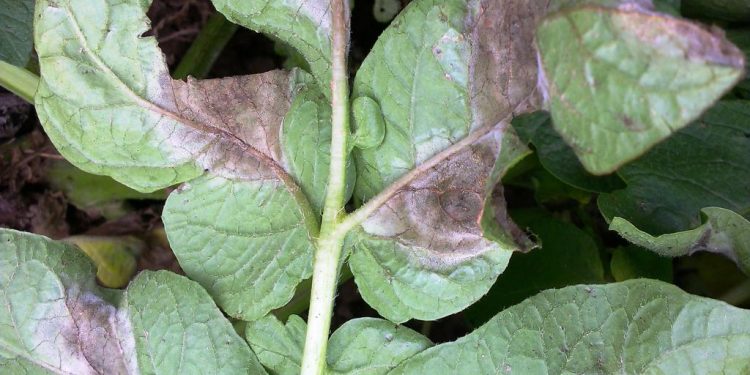The pathogen can grow at a very rapid rate after infection and visible symptoms can appear in a matter of days. If infected tubers enter a store the disease can develop there, leading to huge losses. There are various genotypes of P. infestans present worldwide, which can differ in the amount of disease they cause (their aggressiveness) and their fungicide sensitivity. Changes in these characteristics have the potential to make the disease more damaging and difficult to control.
The main method of dispersal of P. infestans is via air-borne sporangia from infected crops, volunteer potatoes or plants in outgrade piles, although infected seed can also be a source of outbreaks.
Asexual reproduction is rapid and is the most common type. Sporangia can either infect new plants directly or they can release zoospores which disperse in water films before encysting and infecting the plant.
Sexual reproduction is less common. It occurs where the two mating types (A1 an A2) of P. infestans are present in plant tissues. Thick-walled oospores are formed which can persist in soil.
Late blight symptoms on leaves generally appear as irregular shaped dark spots which enlarge as the disease develops. On the upper surface a lighter green halo often surrounds the necrotic area and, on the lower surface, whitish spore–bearing mould develops around the lesions under moist conditions.
Tuber infection symptoms are a darker brown, sometimes purplish, area on the tuber surface. The internal rot is a reddish brown granular rot which can remain close to the surface or progress to the centre of the tuber. Rot development is irregular and sometimes threadlike through the tuber flesh. Late blight causes skin damage which allows opportunistic bacteria to invade and cause soft rotting.
An IPM approach is required to deal with late blight, including:
- Use of more blight resistant cultivars
- Control of primary inoculum sources (volunteer potatoes, outgrade piles, infected crops, seed)
- Use of disease forecasting tools to understand blight risk and target fungicide application accordingly
- Control of tuber blight to avoid storage losses and primary, seed-borne inoculum for the following season
Photo: Maria A. Kuznetsova (All-Russian Phytopathology Research Institute, https://gd.eppo.int/taxon/PHYTIN)

